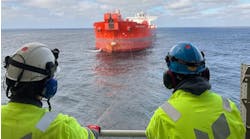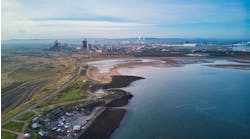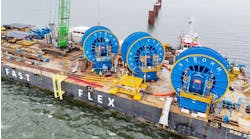UK drilling faces uncertain future
Government hesitation over abolishing UK North Sea royalty taxes is threatening £2 billion worth of investments in mature fields. So claims the UK Offshore Operators Association, which points out that without the proposed change, the marginal tax rate for Forties, Brent, and other mainstay producers will rise from 69% currently to 74%. Ukooa estimates there are 30 fields on the UK shelf onstream since before 1982 that could be affected to varying degrees. This group accounted for 20% of the sector's £3.5 billion capital spend in 2001.
Investors will also think twice about new drilling initiatives, Ukooa adds, but this mindset has been evident for some time, to the point that new exploratory wells on the UK shelf are something of an event. Those that do take the plunge are gaining rewards, suggesting that the sector's reserves are far from spent.
Late in July, UK independent Dana Petroleum announced that the 23/16c-8 well on the Barbara prospect, completed in May by the semi Glomar Arctic IV, had found a liquids-rich gas condensate column similar in quality to BP's nearby Everest and Lomond fields. EnCana, which unearthed the billion-barrel Buzzard field in the central North Sea last year, also reportedly hit light oil and gas with its campaign on Black Horse in blocks 15/22 and 15/23b. Last month, Conoco gave notice of an additional reservoir zone that had come to light during drilling of the Hawksley gas field in the southern sector, as part of its five-field CMS III development.
Activity may pick up following the government's recent award of 25 new offshore licenses under the 20th licensing round. However, majors such as BP were noticeably absent from the bidding. Both EnCana and Amerada Hess, operator of Barbara, picked up operatorships of blocks adjoining their new discoveries. BG was also granted a block next to its current Juno development in the southern gas basin. Several small independents became first-time operators on the shelf, such as OilExCo, Reach Petroleum, and Warwick, the latter formerly a UK onshore player. Most of the license commitments include only one firm exploratory well. License holders still without a work program after two four-year terms must now relinquish their acreage, as part of the government's drive to develop fallow fields.
One of the successful 20th round bidders, Gaz de France, has just filed plans for further development of the Anglia gas field in the southern sector, recently acquired from CalEnergyGas, via up to three new wells. Nearby, ATP has approval for its scheme for Helvellyn, a single-well subsea tieback to BP's Amethyst A2D platform. The Transocean Shelf Explorer is drilling the well, with the Seaway Falcon performing tie-ins.
Delays damage Snøhvit economics
Suspension of work on the Sn hvit LNG project this spring could cause costs to soar by up to $128 million, Statoil says. The near four-month interruption was caused by an investigation into proposed fiscal terms for the development - the first in the Barents Sea - by the European Free Trade Association. Increased charges relate partly to preparations for the gas reception plant on the island of Melkoya. Statoil has pledged, however, to claw back lost time and put the project back within its original budget of $5.13 billion.
At Melkoya, carbon dioxide will be stripped from Snøhvit's incoming wellstream and piped back to the field for injection into the reservoir. This technique was first applied on the Sleipner West field in the North Sea as a way of limiting greenhouse gas emissions. It secured Statoil the technology prize at the World Petroleum Congress in Rio de Janeiro, and the technique will also be applied in a new $410 million subsea development on Sleipner. Three to four wells are being drilled on the Alpha North accumulation, which will be tied back 18 km to the Sleipner T gas treatment platform. Alpha North's CO2 will be separated on the platform and pumped back into the Utsira aquifer.
Elsewhere in the Norwegian sector, PGS looks set to develop Varg South (formerly Rev), but not with subsea wells as seemed likely earlier. It now plans an appraisal well on the field this winter with the aim of proving up 40 MMbbl of oil. If successful, two production wells would be drilled from the Varg wellhead platform.
Deeper horizon yields second discovery
Phillips' Svane-1 probe in the northeast of the Danish Central Graben has been confirmed as a gas-condensate discovery. More significantly, it was the deepest well drilled to date in Danish waters, with a total depth of 5,867 m. The high-pressure/high-temperature (HP/HT) well, drilled by the jackup Ensco 70 in 60 m of water, encountered condensate in late Jurassic sandstone before terminating in Mesozoic strata. Last year, Phillips also found oil in late Jurassic sandstone with the Hejre-1 well, northwest of Svane, which had a TD of 5,265 m.
According to the Danish Energy Agency, exploration of the Central Graben's Jurassic sand layers started in 1967, but has proved problematic until now. Prior to these two wells, no one had succeeded in drilling through the entire Jurassic section, due to difficulties in predicting the location of the sand layers and complications with porosity/permeability. The two recent successes reflect advances in HP/HT drilling and logging technology, and suggest a new exploration fairway may have been established. State oil company DONG also has plans to drill further HP/HT prospects off Denmark.
Four Dutch platforms in prospect
Development activity is resuming off The Netherlands after an unusually quiet spell. Clyde has initiated the first phase of its Q1-B gas field project, based on a normally unmanned, minimal platform located over the Q4-10 discovery well. The field should come onstream next year, with gas piped to Unocal's Hoorn offshore complex for processing. Clyde is also thought to be planning a second-phase platform, following a recent appraisal well on the field drilled by the jackup Noble Lynda Bossler. This is despite the fact that its parent company Conoco wants out of the Dutch sector.
Wintershall also has plans for two platforms on its F16/E18 gasfield, a manned processing installation on F16 and an unmanned satellite structure on E18. The two will be connected by a 5-km, 10-in. pipeline and a control/power umbilical. Late-summer 2004 is the predicted start-up date.
Renewed interest in France
Seismic acquisition surged offshore France in 2001, according to BEPH, the government bureau for exploration and production research. Activity was concentrated offshore Finistere in Brittanny and in the Gulf of Lyons, where a total of 5,979 km of seismic lines were recorded. Aside from 1994, coverage this extensive has not been recorded off France since the early 1980s. By the end of the year, BEPH added, total French offshore exploration permit acreage was unchanged, at 25,735 sq km. But two new non-exclusive reconnaissance permits were awarded on the Atlantic Margin, totaling 10,900 sq km in area. This indicates renewed interest in geophysical exploration, BEPH says. Drilling in recent years has been limited to one-off wells in the Channel and offshore Aquitaine.




